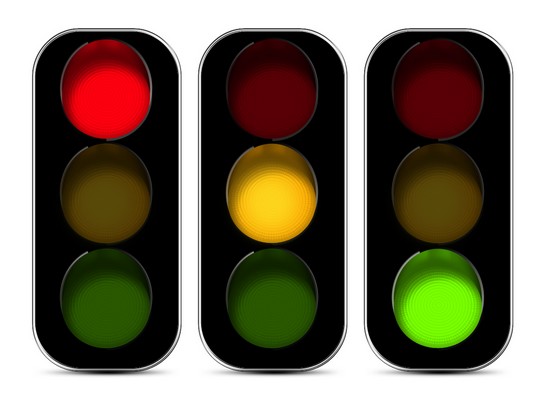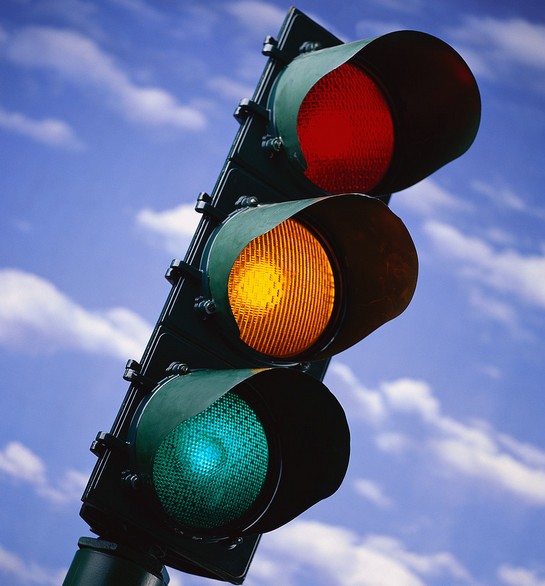Traffic lights are used all over the world and always take the form of red for stop and green for go. Most countries also use an amber light to warn that the light is changing to red and in the UK you are supposed to stop on amber unless you have crossed the stop line or if stopping might cause an accident. In the UK, amber is also used with red to warn that the green light is about to come, though the combination still means ‘stop’, but many countries go straight from red to green. In those countries drivers are often quick to show displeasure at those they feel have not reacted quickly enough.
Flashing amber is also used differently. In the UK it is used at light-controlled pedestrian crossings to indicate that drivers may go if there are no pedestrians on the crossing (it means the same as the orange Belisha beacons on zebra crossings). However, in many countries flashing amber at a junction means proceed with caution.
When you stop at the lights it is safer to put the gearbox in neutral and apply the handbrake. Apart from saving your legs, it means that if your feet slip or something hits your car from behind you are less likely to drive forwards into another car or across the junction. It also means that at night your brake lights are not ruining the night vision of the driver behind, so he’ll still be able to see you when you get moving again. Some automatic gearboxes with a column shift have a push button to engage park from any ‘drive’ position, which locks the transmission so is as good as neutral and the handbrake but easier. However, don’t do that on a UK driving test because it is not the prescribed method. In some countries the driving test demands that automatics are left in drive and the handbrake applied to hold them still, but some vehicles are capable of pulling away with the handbrake on if your foot slips onto the throttle pedal.
There are two main sorts of traffic lights:
- those controlling junctions
- those for pedestrian crossings.
Junction Lights
Follow the rules for turning left and right but only do so when the lights are green. If you are going straight ahead and there is no specific lane for it, stay in the left-hand lane. There is nothing to stop you using the right lane if the arrows on the road show straight ahead and the lane continues on the other side of the junction, but if someone turns right in front of you, you may have to wait behind them.

At complex junctions, green arrow filter lights are used to allow drivers to make left or right turns (a white filter arrow is for trams). Take care not to get into filter lanes unless you want to turn: if you do it by mistake you may be forced to make a turn you don’t want to. (In the USA drivers are allowed to turn right against red lights if it is safe to do so, but this is not allowed in most other countries.)
There is nothing wrong with watching the opposing lights to see when they turn red so you are ready for your green, but do not assume this means yours are going green straightaway. There could be an all-red phase for pedestrians to cross or filter lights may operate.
When the lights go green, put your car in gear and release the handbrake but do not start to pull forwards until the car in front of you starts moving. It is too easy to assume the car in front will move when the driver may not have seen the change or may have a pedestrian in front of them that you can’t see.
Keep Clear
Even when the lights are green, stop at the stop line if your exit from the junction isn’t clear otherwise you may find yourself stuck across it when the lights go green for cars crossing your road.
If you are turning right behind other traffic it is often better to wait your turn at the stop line rather than risk being stuck out in the junction because the person ahead of you couldn’t make the turn or took longer than expected.
Cyclists
In many towns, when cycle lanes meet traffic lights there are two stop lines with a coloured section of road between them for cyclists to stop in. Take care when these lights turn green because some cyclists are slow to set off and many do not consider it necessary to signal their intention to turn right, expecting drivers behind to know they plan to stop again a few metres beyond the stop line.
Timing
Many roads have timed traffic lights that operate in a synchronized way to smooth out traffic flow. When you get a green light, drive at the speed limit and you’ll get a green light at every junction along the road while the boy racers get stopped at every set.










